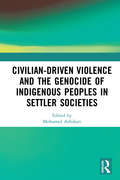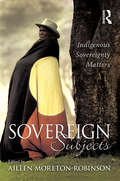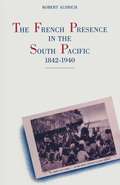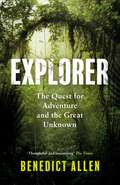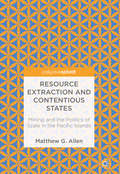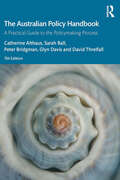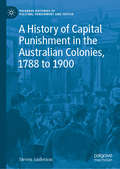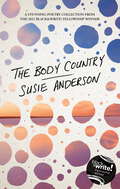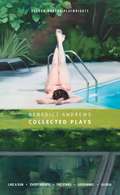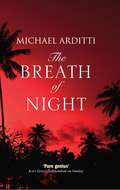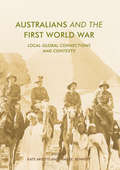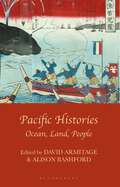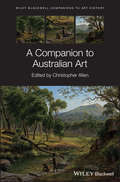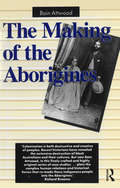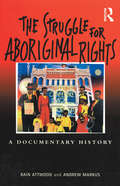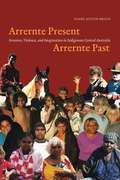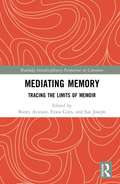- Table View
- List View
Wife
by Samuel Adamson- And your husband forgave you. But what did you do? Decided that forgiveness was offensive and walked out on your marriage. With nothing. Into nothing.- Into everything, I think.It's 1959. Robert leaves Ibsen's A Doll's House outraged by its attack on the sanctity of marriage; his wife Daisy dashes round to the stage door, in love with both Nora and the actress who plays her, thrilled by their promise of escape.Daisy is at the crossroads. Her moral compass tells her to go one way, society the other. What she chooses to do next will have consequences not just for her and Robert, but for four couples who come after them over ninety years.The truth is we have to give up parts of ourselves if we want to be with someone. And what if, before you know this, you run away from the wrong person?Samuel Adamson's Wife premiered at the Kiln Theatre, London, in May 2019.
Civilian-Driven Violence and the Genocide of Indigenous Peoples in Settler Societies
by Mohamed AdhikariExisting studies of settler colonial genocides explicitly consider the roles of metropolitan and colonial states, and their military forces in the perpetration of exterminatory violence in settler colonial situations, yet rarely pay specific attention to the dynamics around civilian-driven mass violence against indigenous peoples. In many cases, however, civilians were major, if not the main, perpetrators of such violence. The focus of this book is thus on the role of civilians as perpetrators of exterminatory violence and on those elements within settler colonial situations that promoted mass violence on their part.
Civilian-Driven Violence and the Genocide of Indigenous Peoples in Settler Societies
by Mohamed AdhikariExisting studies of settler colonial genocides explicitly consider the roles of metropolitan and colonial states, and their military forces in the perpetration of exterminatory violence in settler colonial situations, yet rarely pay specific attention to the dynamics around civilian-driven mass violence against indigenous peoples. In many cases, however, civilians were major, if not the main, perpetrators of such violence. The focus of this book is thus on the role of civilians as perpetrators of exterminatory violence and on those elements within settler colonial situations that promoted mass violence on their part.
Sovereign Subjects: Indigenous sovereignty matters
by Aileen Moreton-Robinson; Rachel Fensham; Jon StrattonIndigenous rights in Australia are at a crossroads. Over the past decade, neo-liberal governments have reasserted their claim to land in Australia, and refuse to either negotiate with the Indigenous owners or to make amends for the damage done by dispossession. Many Indigenous communities are in a parlous state, under threat both physically and culturally.In Sovereign Subjects some of Indigenous Australia's emerging and well-known critical thinkers examine the implications for Indigenous people of continuing to live in a state founded on invasion. They show how for Indigenous people, self-determination, welfare dependency, representation, cultural maintenance, history writing, reconciliation, land ownership and justice are all inextricably linked to the original act of dispossession by white settlers and the ongoing loss of sovereignty.At a time when the old left political agenda has run its course, and the new right is looking increasingly morally bankrupt, Sovereign Subjects sets a new rights agenda for Indigenous politics and Indigenous studies.
The French Presence in the South Pacific, 1842–1940
by Robert AldrichAn examination of France's presence in the South Pacific after the takeover of Tahiti. It places the South Pacific in the context of overall French expansion and current theories of colonialism and imperialism and evaluates the French impact on Oceania.
Explorer: The Quest for Adventure and the Great Unknown
by Benedict AllenWhat does it mean to be an explorer in the twenty-first century? Explorer is the story of what first led Benedict Allen to head for the farthest reaches of our planet – at a time when there were still valleys and ranges known only to the remote communities who inhabited them. It is also the story of why, thirty years later, he is still exploring. It’s the story of a journey back to a clouded mountain in New Guinea to find a man called Korsai who had once been a friend, and to fulfil a promise made as young men. It is also a story of what it is to be ‘lost’ and ‘found’. Honest, sensitive and packed with insight, in Explorer Allen considers the lessons he has learnt from his numerous expeditions – most importantly, from the communities he has encountered and that he has spent so much of his life immersed in. ‘To me personally, exploration isn't about planting flags, conquering Nature, or going somewhere in order to make a mark – it's about the opposite. It's about opening yourself up, allowing yourself to be vulnerable, and letting the place and people make their mark on you.’
Resource Extraction and Contentious States: Mining And The Politics Of Scale In The Pacific Islands
by Matthew G. AllenMining And The Politics Of Scale In The Pacific Islands
The Australian Policy Handbook: A Practical Guide to the Policymaking Process
by Catherine Althaus Sarah Ball Peter Bridgman Glyn Davis David ThrelfallThe seventh edition of this classic handbook on the policy process is fully updated, featuring new material on policy making amid local and global disruption, the contestable nature of modern policy advice, commissioning and contracting, public engagement and policy success and failure. The Australian Policy Handbook shows how public policy permeates every aspect of our lives. It is the stuff of government, justifying taxes, driving legislation and shaping our social services. Public policy gives us roads, railways and airports, emergency services, justice, education and health services, defence, industry development and natural resource management. While politicians make the decisions, public servants provide analysis and support for those choices. This updated edition includes new visuals and introduces a series of case studies for the first time. These cases—covering family violence, behavioural economics, justice reinvestment, child protection and more—illustrate the personal and professional challenges of policymaking practice. Drawing on their extensive practical and academic experience, the authors outline the processes used in making public policy. They systematically explain the relationships between political decision makers, public service advisers, community participants and those charged with implementation. The Australian Policy Handbook remains the essential guide for students and practitioners of policy making in Australia.
The Australian Policy Handbook: A Practical Guide to the Policymaking Process
by Catherine Althaus Sarah Ball Peter Bridgman Glyn Davis David ThrelfallThe seventh edition of this classic handbook on the policy process is fully updated, featuring new material on policy making amid local and global disruption, the contestable nature of modern policy advice, commissioning and contracting, public engagement and policy success and failure. The Australian Policy Handbook shows how public policy permeates every aspect of our lives. It is the stuff of government, justifying taxes, driving legislation and shaping our social services. Public policy gives us roads, railways and airports, emergency services, justice, education and health services, defence, industry development and natural resource management. While politicians make the decisions, public servants provide analysis and support for those choices. This updated edition includes new visuals and introduces a series of case studies for the first time. These cases—covering family violence, behavioural economics, justice reinvestment, child protection and more—illustrate the personal and professional challenges of policymaking practice. Drawing on their extensive practical and academic experience, the authors outline the processes used in making public policy. They systematically explain the relationships between political decision makers, public service advisers, community participants and those charged with implementation. The Australian Policy Handbook remains the essential guide for students and practitioners of policy making in Australia.
A History of Capital Punishment in the Australian Colonies, 1788 to 1900 (Palgrave Histories of Policing, Punishment and Justice)
by Steven AndersonThis book provides a comprehensive overview of capital punishment in the Australian colonies for the very first time. The author illuminates all aspects of the penalty, from shortcomings in execution technique, to the behaviour of the dying criminal, and the antics of the scaffold crowd. Mercy rates, execution numbers, and capital crimes are explored alongside the transition from public to private executions and the push to abolish the death penalty completely. Notions of culture and communication freely pollinate within a conceptual framework of penal change that explains the many transformations the death penalty underwent. A vast array of sources are assembled into one compelling argument that shows how the ‘lesson’ of the gallows was to be safeguarded, refined, and improved at all costs. This concise and engaging work will be a lasting resource for students, scholars, and general readers who want an in-depth understanding of a long feared punishment.Dr. Steven Anderson is a Visiting Research Fellow in the History Department at The University of Adelaide, Australia. His academic research explores the role of capital punishment in the Australian colonies by situating developments in these jurisdictions within global contexts and conceptual debates.
the body country
by Susie Anderson'I keep looking at the stars to see the universe, but the joke is I am the universe.' the body country is an evocative exploration of a world that too often marginalises and the power of a land that can offer connection. A meditation of wandering and wondering on Country, inviting the reader to understand the complexities and changing forms of self and love.A Wergaia and Wemba Wemba woman, Susie Anderson captures profound meaning in moments often lost in the busyness of a day, encouraging us all to stop and allow ourselves the space to notice. To notice the shape of a mouth as it says goodbye; the colour of the sky as you fall in love; the way a steering wheel is turned carelessly after many wines; the crunch of dry ground after drought; the smell of fire on the wind; the movement of ants before rain; the power a word, a dress, a piece of art can give to run towards something new. These are poems that take us across rural and urban settings; from the personal to the universal, from looking inward to mapping the land and always bringing us back to the Country that connects us all.'Anderson pays attention to the moments that slip through the cracks and hands them straight to you in a way that can momentarily stun' Harper's Bazaar'The Body Country is an evocative exploration of a world that too often marginalises and the power of a land that can offer connection. Susie captures profound meaning in moments often lost in the busyness of a day, encouraging us all to stop and allow ourselves the space to notice' Wimmera Mail Times
Benedict Andrews: Collected Plays (Oberon Modern Playwrights)
by Benedict AndrewsBenedict Andrews is an internationally renowned theatre and opera director, a film-maker and a poet. This volume presents the first collection of original plays by a theatre-maker at the top of his game. Includes the plays Like A Sun, Every Breath, The Stars, Geronimo and Gloria. Introduction by Marius von Mayenburg.
The Breath of Night
by Michael ArdittiPhilip Seward travels to the Philippines to investigate the case of a missionary priest imprisoned for murder, where he is drawn into a labyrinth of vice, violence, and corruption where nothing and nobody are what they seem.'Part Conrad, part Waugh, part Greene, and pure genius' Independent on Sunday'This is Arditti's most dazzling novel to date because of the scale of his ambition and his triumph in pulling it off' Peter Stanford, Daily TelegraphWhile working as a missionary priest in the Philippines during the Marcos dictatorship, Julian Tremayne championed the Communist rebels and found himself imprisoned for murder. Now, three decades later, following Julian's death, a cult develops around him, even calling for sainthood. When Philip Seward goes to investigate on behalf of Julian's family, he is drawn into a labyrinth of vice, violence, and corruption where nothing and nobody are what they seem. Enriched by a gallery of engaging characters ranging from priests to prostitutes, GIs to gangsters, and street children to Imelda Marcos, this outstanding novel is at once a gripping psychological thriller, a challenging moral mystery, and an unforgettable voyage into a dark and exotic landscape.
Australians and the First World War: Local-Global Connections and Contexts
by Kate Ariotti James E. BennettThis book contributes to the global turn in First World War studies by exploring Australians’ engagements with the conflict across varied boundaries and by situating Australian voices and perspectives within broader, more complex contexts. This diverse and multifaceted collection includes chapters on the composition and contribution of the Australian Imperial Force, the experiences of prisoners of war, nurses and Red Cross workers, the resonances of overseas events for Australians at home, and the cultural legacies of the war through remembrance and representation. The local-global framework provides a fresh lens through which to view Australian connections with the Great War, demonstrating that there is still much to be said about this cataclysmic event in modern history.
Australians and the First World War: Local-Global Connections and Contexts
by Kate Ariotti James E. BennettThis book contributes to the global turn in First World War studies by exploring Australians’ engagements with the conflict across varied boundaries and by situating Australian voices and perspectives within broader, more complex contexts. This diverse and multifaceted collection includes chapters on the composition and contribution of the Australian Imperial Force, the experiences of prisoners of war, nurses and Red Cross workers, the resonances of overseas events for Australians at home, and the cultural legacies of the war through remembrance and representation. The local-global framework provides a fresh lens through which to view Australian connections with the Great War, demonstrating that there is still much to be said about this cataclysmic event in modern history.
Pacific Histories: Ocean, Land, People
by David Armitage Alison BashfordThe first comprehensive account to place the Pacific Islands, the Pacific Rim and the Pacific Ocean into the perspective of world history. A distinguished international team of historians provides a multidimensional account of the Pacific, its inhabitants and the lands within and around it over 50,000 years, with special attention to the peoples of Oceania. It providing chronological coverage along with analyses of themes such as the environment, migration and the economy; religion, law and science; race, gender and politics.
A Companion to Australian Art (Blackwell Companions to Art History)
by Dana ArnoldAn accessible and balanced introduction to the history of Australian art from colonization to the present The Companion to Australian Art is a thorough introduction to the art produced in Australia beginning from the arrival of the First Fleet in 1788. Focusing on the colonial art tradition of Australia's European settlers, this volume presents a collection of clear, accessible, and well-focused essays by established art historians and emerging scholars alike. Engaging, jargon-free chapters provide fresh insights on various Australian artforms in different chronological, regional, and thematic contexts. The text provides a balanced and unbiased description of historical events to help readers encounter the art of Australia on their own terms and draw their own conclusions. The book begins by surveying the historiography of Australian art and exploring the history of art museums in Australia. The following chapters discuss artforms such as photography, sculpture, portraiture, and landscape painting, and examine the art traditions of the separate colonies up to Federation in 1901, and then the art tradition of the Commonwealth from the early nineteenth century to the present. This authoritative volume: Helps non-specialist readers understand and appreciate the art of Australia Covers 250 years of art movements in Australia, including Neo-classicism, Romanticism, Realism, Impressionism, and the various forms of Modernism Explores the way Australian art has been considered and exhibited since the beginning of colonization Discusses the state of contemporary art and how traditional Aboriginal art has adapted and changed over the last half-century Offers new perspectives on cultural and aesthetic debates both past and present The Companion to Australian Art is a valuable resource for both undergraduate and graduate students of the history of Australian artforms from colonization to postmodernism, and for general readers with an interest in the nation’s colonial art history.
A Companion to Australian Art (Blackwell Companions to Art History)
by Dana ArnoldA Companion to Australian Art A Companion to Australian Art is a thorough introduction to the art produced in Australia from the arrival of the First Fleet in 1788 to the early 21st century. Beginning with the colonial art made by Australia’s first European settlers, this volume presents a collection of clear and accessible essays by established art historians and emerging scholars alike. Engaging, clearly-written chapters provide fresh insights into the principal Australian art movements, considered from a variety of chronological, regional and thematic perspectives.The text seeks to provide a balanced account of historical events to help readers discover the art of Australia on their own terms and draw their own conclusions. The book begins by surveying the historiography of Australian art and exploring the history of art museums in Australia. The following chapters discuss art forms such as photography, sculpture, portraiture and landscape painting, examining the practice of art in the separate colonies before Federation, and in the Commonwealth from the early 20th century to the present day. This authoritative volume covers the last 250 years of art in Australia, including the Early Colonial, High Colonial and Federation periods as well as the successive Modernist styles of the 20th century, and considers how traditional Aboriginal art has adapted and changed over the last fifty years.The Companion to Australian Art is a valuable resource for both undergraduate and graduate students of the history of Australian artforms from colonization to postmodernism, and for general readers with an interest in the nation’s colonial art history.
The Making of the Aborigines
by Bain AttwoodBefore 1788, the peoples of this continent did not consider themselves 'Aboriginal'. They only became 'Aborigines' in the wake of the British invasion. In this startling and original study, Bain Attwood reveals how relationships between black Australians and European colonisers determined the hearts and minds of the indigenous peoples, making them anew as Aboriginals.In examining the period after the 'killing times', this young historian provides new perspectives on racial ideology, government policy, and the rule of law. In examining European domination, he unravels the patterns of associations which were woven between European and Aborigine, and shows the complex meanings and significance these relationships held for both groups.In this book, the dispossessed are not cast as merely passive victims; they appear as real characters, men and women who adapted to European colonisation in accordance with their own historical and cultural experience. Out of this exchange the colonised created a new consciousness and began to forge a common identity for themselves.A story of cultural change and continuity both poignant and disturbing in its telling, this important book is sure to provoke controversy about what it means to be Aboriginal.'This intelligent and impeccably researched book seeks to advance our understanding of the story of white/Aboriginal contact. It will be required reading for anyone working in the field.' - Henry Reynolds'Colonisation is both destructive and creative of peoples. Recent historians have revealed the extensive destruction of black Australians and their cultures. But now Bain Attwood, in this finely crafted and highly original series of case studies. plots the complex human relations and historical forces that re-made these indigenous people into the Aborigines.' - Richard Broome
The Making of the Aborigines
by Bain AttwoodBefore 1788, the peoples of this continent did not consider themselves 'Aboriginal'. They only became 'Aborigines' in the wake of the British invasion. In this startling and original study, Bain Attwood reveals how relationships between black Australians and European colonisers determined the hearts and minds of the indigenous peoples, making them anew as Aboriginals.In examining the period after the 'killing times', this young historian provides new perspectives on racial ideology, government policy, and the rule of law. In examining European domination, he unravels the patterns of associations which were woven between European and Aborigine, and shows the complex meanings and significance these relationships held for both groups.In this book, the dispossessed are not cast as merely passive victims; they appear as real characters, men and women who adapted to European colonisation in accordance with their own historical and cultural experience. Out of this exchange the colonised created a new consciousness and began to forge a common identity for themselves.A story of cultural change and continuity both poignant and disturbing in its telling, this important book is sure to provoke controversy about what it means to be Aboriginal.'This intelligent and impeccably researched book seeks to advance our understanding of the story of white/Aboriginal contact. It will be required reading for anyone working in the field.' - Henry Reynolds'Colonisation is both destructive and creative of peoples. Recent historians have revealed the extensive destruction of black Australians and their cultures. But now Bain Attwood, in this finely crafted and highly original series of case studies. plots the complex human relations and historical forces that re-made these indigenous people into the Aborigines.' - Richard Broome
The Struggle for Aboriginal Rights: A documentary history
by Bain Attwood Andrew MarkusThe Struggle for Aboriginal Rights is the first book of its kind. Not only does it tell the history of the political struggle for Aboriginal rights in all parts of Australia; it does so almost entirely through a selection of historical documents created by the Aboriginal campaigners themselves, many of which have never been published. It presents Aboriginal perspectives of their dispossession and their long and continuing fight to overcome this. In charting the story of Aboriginal political activity from its beginnings on Flinders Island in the 1830s to the fight over native title today, this book aims to help Australians better understand both the continuities and the changes in Aboriginal politics over the last 150 years: in the leadership of the Aboriginal political struggle, the objectives of these campaigners for rights for Aborigines, their aspirations, the sources of their programmes for change, their methods of protest, and the outcomes of their protest. Through the words of Aboriginal activists, across 150 years, The Struggle for Aboriginal Rights charts the relationship between political involvement and Aboriginal identity.
Arrernte Present, Arrernte Past: Invasion, Violence, and Imagination in Indigenous Central Australia
by Diane J. Austin-BroosThe Arrernte people of Central Australia first encountered Europeans in the 1860s as groups of explorers, pastoralists, missionaries, and laborers invaded their land. During that time the Arrernte were the subject of intense curiosity, and the earliest accounts of their lives, beliefs, and traditions were a seminal influence on European notions of the primitive. The first study to address the Arrernte’s contemporary situation, Arrernte Present, Arrernte Past also documents the immense sociocultural changes they have experienced over the past hundred years. Employing ethnographic and archival research, Diane Austin-Broos traces the history of the Arrernte as they have transitioned from a society of hunter-gatherers to members of the Hermannsburg Mission community to their present, marginalized position in the modern Australian economy. While she concludes that these wrenching structural shifts led to the violence that now marks Arrernte communities, she also brings to light the powerful acts of imagination that have sustained a continuing sense of Arrernte identity.
Arrernte Present, Arrernte Past: Invasion, Violence, and Imagination in Indigenous Central Australia (The\bush School Series In The Economics Of Public Policy)
by Diane J. Austin-BroosThe Arrernte people of Central Australia first encountered Europeans in the 1860s as groups of explorers, pastoralists, missionaries, and laborers invaded their land. During that time the Arrernte were the subject of intense curiosity, and the earliest accounts of their lives, beliefs, and traditions were a seminal influence on European notions of the primitive. The first study to address the Arrernte’s contemporary situation, Arrernte Present, Arrernte Past also documents the immense sociocultural changes they have experienced over the past hundred years. Employing ethnographic and archival research, Diane Austin-Broos traces the history of the Arrernte as they have transitioned from a society of hunter-gatherers to members of the Hermannsburg Mission community to their present, marginalized position in the modern Australian economy. While she concludes that these wrenching structural shifts led to the violence that now marks Arrernte communities, she also brings to light the powerful acts of imagination that have sustained a continuing sense of Arrernte identity.
Arrernte Present, Arrernte Past: Invasion, Violence, and Imagination in Indigenous Central Australia (The\bush School Series In The Economics Of Public Policy)
by Diane J. Austin-BroosThe Arrernte people of Central Australia first encountered Europeans in the 1860s as groups of explorers, pastoralists, missionaries, and laborers invaded their land. During that time the Arrernte were the subject of intense curiosity, and the earliest accounts of their lives, beliefs, and traditions were a seminal influence on European notions of the primitive. The first study to address the Arrernte’s contemporary situation, Arrernte Present, Arrernte Past also documents the immense sociocultural changes they have experienced over the past hundred years. Employing ethnographic and archival research, Diane Austin-Broos traces the history of the Arrernte as they have transitioned from a society of hunter-gatherers to members of the Hermannsburg Mission community to their present, marginalized position in the modern Australian economy. While she concludes that these wrenching structural shifts led to the violence that now marks Arrernte communities, she also brings to light the powerful acts of imagination that have sustained a continuing sense of Arrernte identity.
Mediating Memory: Tracing the Limits of Memoir (Routledge Interdisciplinary Perspectives on Literature)
by Bunty Avieson Fiona Giles Sue JosephThe argument has been made that memoir reflects and augments the narcissistic tendencies of our neo-liberal age. Mediating Memory: Tracing the Limits of Memoir challenges and dismantles that assumption. Focusing on the history, theory and practice of memoir writing, editors Bunty Avieson, Fiona Giles and Sue Joseph provide a thorough and cutting-edge examination of memoir through the lenses of ethics, practice and innovation. By investigating memoir across cultural boundaries, in its various guises, and tracing its limits, the editors convincingly demonstrate the plurality of ways in which memoir is helping us make sense of who we are, who we were and the influences that shape us along the way.

